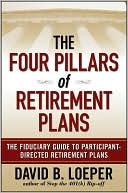List Books » The Four Pillars of Retirement Plans: The Fiduciary Guide to Participant Directed Retirement Plans
Category Books
- Fiction Books & Literature
- Graphic Novels
- Horror
- Mystery & Crime
- Poetry
- Romance Books
- Science Fiction & Fantasy
- Thrillers
- Westerns
- Ages 0-2
- Ages 3-5
- Ages 6-8
- Ages 9-12
- Teens
- Children's Books
- African Americans
- Antiques & Collectibles
- Art, Architecture & Photography
- Bibles & Bible Studies
- Biography
- Business Books
- Christianity
- Computer Books & Technology Books
- Cookbooks, Food & Wine
- Crafts & Hobbies Books
- Education & Teaching
- Engineering
- Entertainment
- Foreign Languages
- Game Books
- Gay & Lesbian
- Health Books, Diet & Fitness Books
- History
- Home & Garden
- Humor Books
- Judaism & Judaica
- Law
- Medical Books
- New Age & Spirituality
- Nonfiction
- Parenting & Family
- Pets
- Philosophy
- Political Books & Current Events Books
- Psychology & Psychotherapy
- Reference
- Religion Books
- Science & Nature
- Self Improvement
- Sex & Relationships
- Social Sciences
- Sports & Adventure
- Study Guides & Test Prep
- Travel
- True Crime
- Weddings
- Women's Studies
The Four Pillars of Retirement Plans: The Fiduciary Guide to Participant Directed Retirement Plans »

Authors: David B. Loeper
ISBN-13: 9780470449998, ISBN-10: 0470449993
Format: Hardcover
Publisher: Wiley, John & Sons, Incorporated
Date Published: June 2009
Edition: (Non-applicable)
Author Biography: David B. Loeper
David B. Loeper is the founder and CEO of Financeware, Inc. He has appeared on CNBC and Bloomberg TV, served on the Investment Advisory Committee of the $30 billion Virginia Retirement System, and was chairman of the Advisory Council for the Investment Management Consultants Association (IMCA). He earned the CIMA designation (Certified Investment Management Analyst) from Wharton Business School in 1990 in conjunction with IMCA. Loeper is also the author of Stop the Retirement Rip-off and Stop the Investing Rip-off, both published by Wiley.
Book Synopsis
In the February 2008 landmark Supreme Court ruling LaRue v. DeWolff, Boberg & Associates, Inc., the Court ruled on the ability of an individual participant to sue retirement plan fiduciaries. This ruling significantly changed the landscape of fiduciary liability and risks for trustees. With the Court's decision that any individual can sue for breaches based solely on the impairment of their personal plan balances, a potential floodgate of new lawsuits may have been opened. This has profound implications for exercising new forms of procedural prudence designed specifically for participant-directed funding and investment selection.
The Four Pillars of Retirement Plans provides a road map that all fiduciaries can use to adjust their actions to shelter themselves from the massive liabilities they may face-as well as serving as a guide for attorneys representing retirement plan participants.
Drawing on his nearly twenty-five years of ERISA experience as a fiduciary, author, and Registered Investment Advisor, David Loeper details his four pillars of retirement plans-the specific four pillars of ERISA concepts that need procedural adjustment by trustees and advisors. In Part I of the book, he examines each of the four pillars from a perspective of the changing landscape toward participant-directed retirement plans, the generally accepted procedures of the past that have become outdated, the actions all fiduciaries need to take to adjust to this landscape, and perhaps, more importantly, the rationale behind such changes. In Part II, he explains to plan sponsors, investment managers, plan consultants, and fiduciaries why the Supreme Court's ruling will change the environment for measuring their responsibilities and liabilities in years to come. In Part III, he offers some practical solutions to these new problems, identifying how some of the "safest" fiduciary actions are no longer so safe, what you can do about getting ahead of the curve to avoid needless liability, and where to locate free resources that fiduciaries can use to help mitigate their risks and help to document procedural prudence in the future landscape for participant-directed plans.
For financial advisors, attorneys, and other fiduciaries, The Four Pillars of Retirement Plans will be an invaluable resource for dealing with the monumental changes ahead.
Table of Contents
Acknowledgments.
Introduction.
Part One: Pillars Made of Sand?
Chapter 1 The Four Pillars of Fiduciary Conduct.
Chapter 2 Pillar #1: Assets Are Invested for the Sole Benefit of Participants.
Chapter 3 Pillar #2: Minimize Risk of Large Losses.
Chapter 4 Pillar #3: Costs Are Reasonable for the Services Being Provided.
Chapter 5 Pillar #4: Diversifi cation Rule Applied to Participant Direction.
Part Two: Returns and Wealth Do Not Necessarily Go Hand in Hand—Emerging Fiduciary Standards.
Chapter 6 Exposing the Wealth Management Contradiction.
Chapter 7 Comparing Approaches—Managing Wealth versus Managing Return.
Chapter 8 Market Misbehavior: Over- or Underfunding Investor Goals.
Chapter 9 The Data: Seeing the Effect of Real Markets on Client Goals.
Chapter 10 Superior Results with True Wealth Management.
Part Three: Practical Solutions and Resources for Meeting Fiduciary Obligations.
Chapter 11 Safe Harbors that Are Unsafe (Particularly Section 404(C)).
Chapter 12 Tools and Resources for Fiduciaries.
Chapter 13 The Skill versus Luck Debate.
Summary.
Notes.
About the Author.
Index.
Subjects
 Personal Finance & Investing
Personal Finance & Investing  Retirement Planning
Retirement PlanningBusiness Books
 Professional Finance & Investing
Professional Finance & Investing  Investing & Finance - General & Miscellaneous
Investing & Finance - General & MiscellaneousSelf Improvement
 Aging
Aging  Retirement
RetirementSelf Improvement
 See All
See All  Self - Improvement
Self - Improvement
